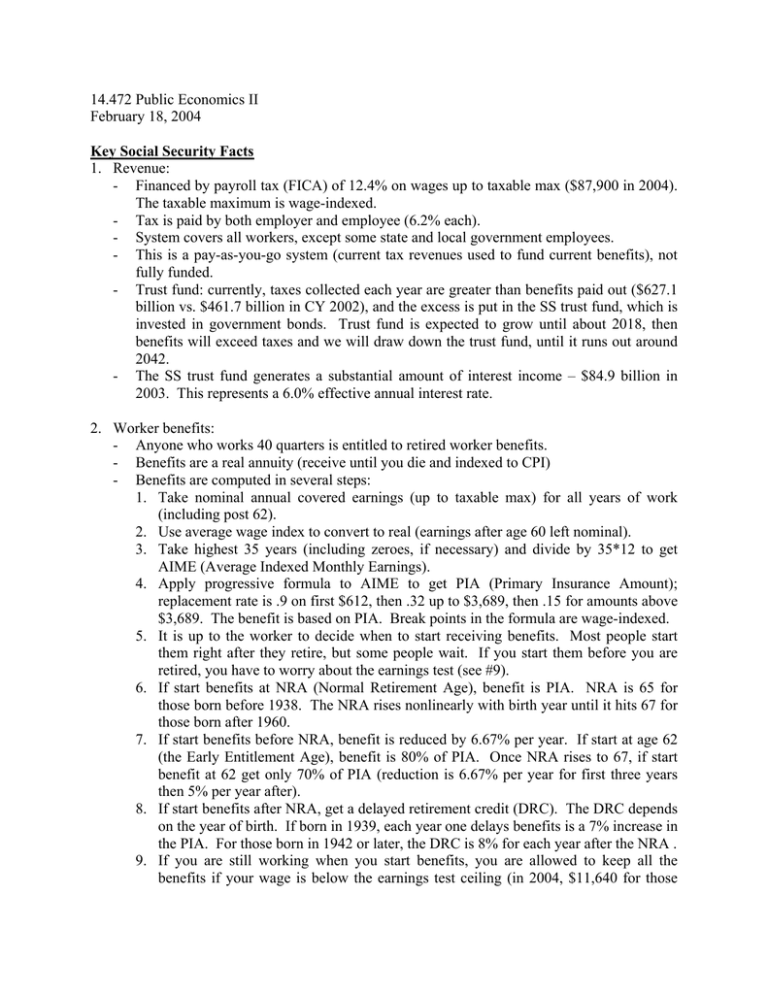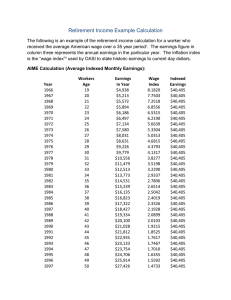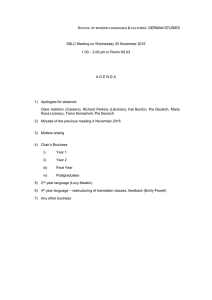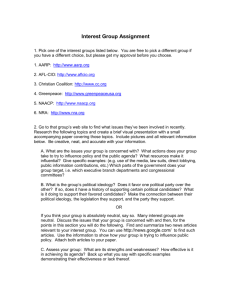14.472 Public Economics II February 18, 2004 1. Revenue:
advertisement

14.472 Public Economics II February 18, 2004 Key Social Security Facts 1. Revenue: - Financed by payroll tax (FICA) of 12.4% on wages up to taxable max ($87,900 in 2004). The taxable maximum is wage-indexed. - Tax is paid by both employer and employee (6.2% each). - System covers all workers, except some state and local government employees. - This is a pay-as-you-go system (current tax revenues used to fund current benefits), not fully funded. - Trust fund: currently, taxes collected each year are greater than benefits paid out ($627.1 billion vs. $461.7 billion in CY 2002), and the excess is put in the SS trust fund, which is invested in government bonds. Trust fund is expected to grow until about 2018, then benefits will exceed taxes and we will draw down the trust fund, until it runs out around 2042. - The SS trust fund generates a substantial amount of interest income – $84.9 billion in 2003. This represents a 6.0% effective annual interest rate. 2. Worker benefits: - Anyone who works 40 quarters is entitled to retired worker benefits. - Benefits are a real annuity (receive until you die and indexed to CPI) - Benefits are computed in several steps: 1. Take nominal annual covered earnings (up to taxable max) for all years of work (including post 62). 2. Use average wage index to convert to real (earnings after age 60 left nominal). 3. Take highest 35 years (including zeroes, if necessary) and divide by 35*12 to get AIME (Average Indexed Monthly Earnings). 4. Apply progressive formula to AIME to get PIA (Primary Insurance Amount); replacement rate is .9 on first $612, then .32 up to $3,689, then .15 for amounts above $3,689. The benefit is based on PIA. Break points in the formula are wage-indexed. 5. It is up to the worker to decide when to start receiving benefits. Most people start them right after they retire, but some people wait. If you start them before you are retired, you have to worry about the earnings test (see #9). 6. If start benefits at NRA (Normal Retirement Age), benefit is PIA. NRA is 65 for those born before 1938. The NRA rises nonlinearly with birth year until it hits 67 for those born after 1960. 7. If start benefits before NRA, benefit is reduced by 6.67% per year. If start at age 62 (the Early Entitlement Age), benefit is 80% of PIA. Once NRA rises to 67, if start benefit at 62 get only 70% of PIA (reduction is 6.67% per year for first three years then 5% per year after). 8. If start benefits after NRA, get a delayed retirement credit (DRC). The DRC depends on the year of birth. If born in 1939, each year one delays benefits is a 7% increase in the PIA. For those born in 1942 or later, the DRC is 8% for each year after the NRA . 9. If you are still working when you start benefits, you are allowed to keep all the benefits if your wage is below the earnings test ceiling (in 2004, $11,640 for those - under the NRA and $31,080 for the NRA year; no test after that). After that, lose $1 in benefit for every $2 ($3) in earnings if age between 62-NRA (NRA year). There is a complex formula for increasing your benefit later if you lose benefits due to the earnings test. Benefits are subject to income tax only if have more than $32,000 ($25,000) in non-SS income for a couple (single person); most people don’t pay tax on them. $12.7 billion in revenues to the trust fund came from taxation of benefits in 2001. Revenue from the taxation of the first 50% of benefits goes to the SS Trust Fund. Additional revenue from taxation of up to 85% of benefits goes to the Medicare Hospital Insurance Trust Fund. There are disability benefits too. Can qualify with less than 40 quarters if young; benefits are based on <35 years of earnings. To qualify, must pass medical screening process and not have worked for last 6 months. 3. Family benefits: - Law is gender-neutral (but most dependents are women, so I’ll use that language) - A dependent spouse is eligible for a benefit of 50% of the worker’s PIA. The dependent can start this benefit as soon as she is 62 and her spouse has started receiving his benefit. The spouse’s benefit is reduced if she starts it before she reaches the NRA (slope is a little steeper than above) - A dependent spouse may also be entitled to her own retired worker benefit. If so, she receives the larger of the two benefits (technically, she first gets her retired worker benefit, then it is topped up to the amount of the spouse benefit if applicable). - A surviving spouse gets 100% of the worker’s PIA. This benefit is first available at age 60 and it is reduced if the worker started benefits before his NRA or if the survivor started the benefit before her NRA. Also, a younger surviving spouse with dependent children can get benefits. - There is also a benefit for children under 18 of deceased, retired, or disabled workers of 75% of the worker’s PIA; however, the family as a whole can get no more than 175% of the worker’s PIA.








